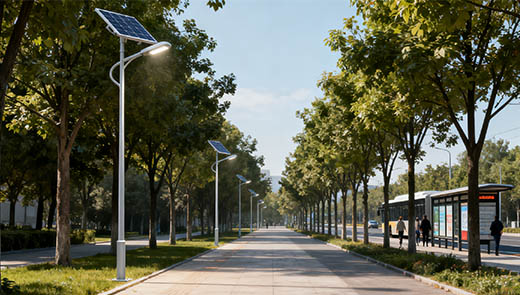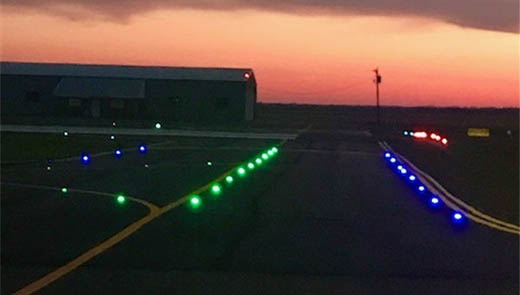How to choose the best solar-powered LED parking lot lights?
Solar LED parking lot lights are an independent lighting system that relies on photovoltaic technology to achieve “daytime energy storage and nighttime illumination.” They do not rely on the power grid and combine the low energy consumption advantages of LEDs to balance environmental protection, cost, and lighting stability in parking lot scenarios. Their emergence addresses issues such as electricity costs, wiring, and power outage failures associated with traditional lighting systems, while also providing more flexible lighting solutions for parking lots of various sizes.
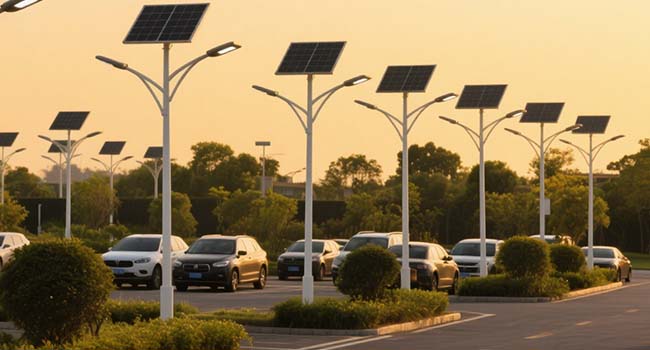
What Are Solar Parking Lot Lights, and How Do They Work?
Solar-powered LED parking lot lights are an illumination system that uses solar energy as its core power source. The core principle is to achieve a cycle of “daytime energy storage and nighttime illumination” through photovoltaic technology. During the day, the photovoltaic (PV) panels on the top of the light fixture absorb sunlight, convert it into electrical energy, and store it in the battery. At night or on cloudy days, the electrical energy stored in the battery is regulated by the charge controller to power the LED fixtures. The charge controller can also automatically switch the lighting on and off based on ambient light levels, such as turning on automatically at dusk and off at dawn, without any manual intervention.
Components of Solar Parking Lot Light Systems
The core advantage of this system is its ability to operate independently of the grid. Without the need to connect to traditional power lines, it eliminates electricity costs and line maintenance expenses. Additionally, LED lights themselves feature low energy consumption and a long lifespan, and when combined with a solar system, they can maximize their value in scenarios requiring long-term lighting, such as parking lots.
Structurally, the solar parking lot light system consists of six core components. Photovoltaic (PV) panels handle energy conversion, batteries store energy, LED lights provide illumination, charge controllers manage energy distribution and operational control, light poles provide structural support and height stability, and some products may include motion sensors (optional) that adjust brightness based on vehicle or pedestrian activity, further reducing energy consumption. These components work together to ensure stable lighting while maximizing energy efficiency.
Benefits of Solar Street Lights for Parking Lots
Choosing solar LED lights for parking lot lighting addresses the pain points of traditional lighting from multiple dimensions.
Sustainability
In terms of sustainability, traditional parking lot lights rely on grid power, which is primarily generated from fossil fuels, resulting in carbon emissions during use. Solar LED lights utilize sunlight as their energy source, a renewable and clean energy source, and produce virtually no additional carbon emissions throughout their entire life cycle, making them a direct means of practicing green and environmentally friendly principles.
Cost-Efficiency
In terms of cost-effectiveness, while the initial purchase cost of solar LED lights is slightly higher than traditional lighting, their long-term economic benefits are significant. On one hand, they eliminate the need for electricity bills, allowing a medium-sized parking lot to save a substantial amount on electricity costs annually. On the other hand, LED fixtures have a lifespan of 5–10 years, and the photovoltaic panels and batteries can last over 5 years. Routine maintenance requires only simple cleaning, with virtually no additional expenses.
Reliable Safety
In terms of safety and reliability, traditional lighting systems become completely inoperable during power outages, potentially plunging parking lots into darkness and creating safety hazards. Solar LED lights, equipped with built-in energy storage batteries, can continue to provide illumination even during grid power outages, ensuring the safety of vehicles and pedestrians. Additionally, LED lighting systems offer stable illumination, eliminating the flickering issues common in traditional bulbs, and provide consistent, uniform lighting.
Effortless Installation
In terms of installation convenience, traditional parking lot lights require cable laying and trench digging, which not only prolongs the construction period (typically 3-5 days) but may also damage the parking lot surface. Solar LED lights require no wiring connections; simply secure the light poles and connect the components. The installation time for a standard light fixture can be reduced to 1-2 hours, minimizing disruption to normal parking lot operations.
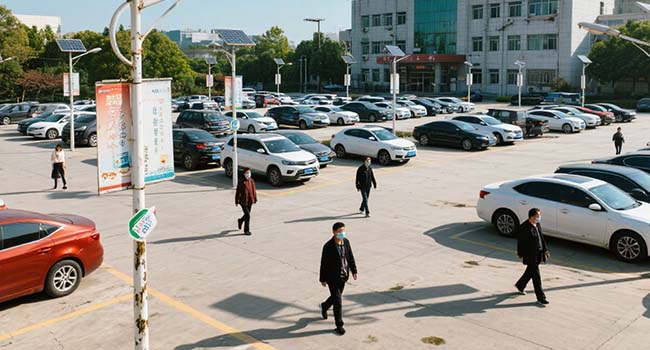
How to Choose the Right Solar Parking Lot Light for Your Space?
Luminaire Quality
The quality of the luminaire directly determines the lighting effect of the parking lot, and the lighting effect is the core of ensuring parking safety. Insufficient brightness may lead to vehicle collisions, and uneven coverage may create surveillance blind spots. When selecting a luminaire, three key factors should be considered. First, the performance of the LED chips. Prioritize products with a power factor >95% and energy conversion efficiency >40%, as these chips can emit more stable light at the same energy consumption.
Second, the beam angle. 120° is the optimal angle for parking lots, as it covers a sufficiently wide area (a single light can cover approximately 200㎡) without causing insufficient brightness at the edges due to an overly wide angle. Third, the luminaire structure design. The base should use high-reflectivity materials (such as aluminum reflectors) to reflect backward-scattered light back into the illuminated area. The lens should use high-transmittance glass or acrylic materials to prevent light absorption by the material.
Luminaire Efficacy
Luminaire efficacy refers to the “brightness produced per unit of energy consumption,” measured in “lumens per watt (lm/W).” The higher this value, the more light the luminaire can emit under the same power consumption. For solar lights, efficacy is the key to whether they can sustain lighting throughout the night. Nighttime illumination relies on stored battery power. Luminaires with low efficacy quickly deplete battery power and may shut off by dawn due to insufficient power. Generally, parking lot lighting must ensure at least 8 hours of continuous illumination (from dusk to dawn), so products with efficacy ≥100 lm/W are recommended. In regions with frequent cloudy weather, efficacy should be further increased to 120 lm/W or higher.
Photovoltaic Panels and Batteries
Photovoltaic panels and batteries are the “energy core” of a solar system, and their performance directly determines the lamp's runtime. The selection of photovoltaic panels should be based on local sunlight conditions. In areas with abundant sunlight (such as southern regions), monocrystalline silicon panels with a power rating of 200-300W can be chosen, with a conversion efficiency of approximately 18-22%. In regions with weaker sunlight (such as northern winters or areas with frequent cloudy and rainy weather), it is recommended to choose high-efficiency panels of 300W or higher, paired with polycrystalline silicon material to enhance low-light conversion capabilities.
Battery selection should focus on capacity and type. In terms of capacity, if 10 hours of continuous lighting is required overnight, batteries with a capacity of 100Ah or higher are recommended. In terms of type, lithium-ion batteries are superior to lead-acid batteries, with a cycle life of over 2,000 cycles (approximately 5 years) and more stable low-temperature performance, making them suitable for northern regions. Additionally, batteries must have overcharge and over-discharge protection features to prevent damage caused by extreme weather conditions.
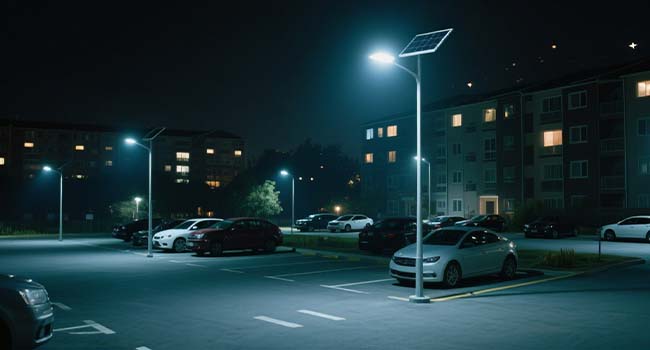
PIR Motion Sensor
The PIR motion sensor is a key component for enhancing the energy efficiency of solar lights. Parking lots do not require full brightness lighting at all times during the night, as most periods are low-activity periods. Lights equipped with PIR sensors can detect vehicle or pedestrian activity, automatically increasing to full brightness when motion is detected and reducing to 30% brightness or turning off when no activity is detected, thereby reducing energy consumption by over 50%.
When selecting sensors, pay attention to their sensitivity and detection range. High-quality sensors should have a detection distance of 8–10 meters, a coverage angle of 120°, and adjustable delay settings (e.g., 30 seconds to 5 minutes). These settings can be adjusted based on parking lot traffic volume—for example, shopping mall parking lots with high traffic volume can set shorter delays, while residential area parking lots with low traffic volume can set longer delays.
Waterproof Certification
Parking lot lighting fixtures are exposed to outdoor conditions and must withstand natural elements such as rain, snow, and dust. Waterproof performance directly affects the lifespan of the fixtures. The internationally recognized waterproof rating standard is IP (Ingress Protection), where IP65 indicates complete protection against dust ingress and resistance to low-pressure water jets (e.g., light rain). IP66 can withstand high-pressure water jets (such as heavy rain). IP67 can withstand temporary immersion in water (such as in flooded areas).
Parking lot lighting fixtures should be selected with a minimum IP65 rating. If the region experiences frequent rain or typhoons, the rating should be upgraded to IP66 or higher. Additionally, the wiring connections of the fixtures should be checked for sealed designs to prevent rainwater from seeping into internal components through the connection points.
Installation Brackets and Light Poles
Installation brackets and light poles are the foundation for ensuring the stability of lighting fixtures. The brackets must support the total weight of the photovoltaic panels, lighting fixtures, and batteries (typically 5–10 kg). Materials should be galvanized steel or aluminum alloy with a thickness of ≥2 mm, and the surface must undergo corrosion-resistant treatment (e.g., powder coating) to prevent rusting from prolonged exposure to rain.
The height of the light poles should be determined based on lighting coverage requirements. For small parking lots, 6-8 meter light poles can be selected, while for large parking lots, 8-10 meter light poles are recommended, paired with adjustable brackets to adjust the panel angle (a 30° tilt angle is recommended for southern regions, and a 45° tilt angle for northern regions to maximize sunlight reception). Additionally, the base of the light pole must have pre-drilled bolt holes for fixation. During installation, the base must be poured with concrete to ensure wind resistance of grade 10 or above to withstand typhoon conditions.

Step-by-Step Installation Guide
Site assessment is the first step. Select an unobstructed location (away from trees and building shadows) to ensure the photovoltaic panels receive over 6 hours of direct sunlight daily. Additionally, confirm the ground hardness at the installation site to prevent the light pole from tilting due to soft ground.
When preparing the installation surface, clear debris from the ground and use a level to confirm the surface is flat. If the ground is soil, pour a 30cm × 30cm × 30cm concrete base in advance, allowing it to cure before installation.
When installing the solar panels, adjust the tilt angle according to the local latitude (e.g., adjust to 30° in a region at 30° north latitude), secure them to the top of the light pole using brackets, and ensure the panels face due south (in the Northern Hemisphere) with no leaves or wires obstructing them.
Electrical wiring connections must be made strictly in accordance with the manual. First connect the photovoltaic panels to the charge controller, then connect the battery to the controller, and finally connect the lighting fixtures to the controller, ensuring the positive and negative terminals are not reversed. All wiring terminals must be wrapped with waterproof tape, and the controller must be installed in a waterproof enclosure to prevent water ingress.
When installing lighting fixtures, adjust the fixture angle to ensure the light beam covers the core area of the parking lot (e.g., lanes, parking spaces) and avoids direct illumination of residents' windows (Shade plates can be installed if needed).
During system testing, cover the photovoltaic panels with a light-blocking cloth during the day to simulate nighttime conditions and observe whether the lighting fixtures automatically turn on. Test the sensor sensitivity at night by walking through the detection area to confirm that the brightness switches normally.
Final adjustments primarily focus on the angle of the photovoltaic panels. If the lighting fixtures turn off prematurely for several consecutive days, it may be due to an improper panel angle. Adjust the angle slightly to increase power generation. If the light brightness is unstable, check if the wiring is loose and reinforce the connections.
When selecting solar LED parking lot lights, the key is to match actual requirements such as sunlight exposure, lighting duration, and traffic volume, while balancing factors like fixture quality, photovoltaic performance, and battery performance to achieve the goal of “stable lighting even off the grid.” Not only does this reduce carbon emissions, but it also enhances long-term benefits by saving on electricity costs and reducing maintenance expenses, making it an excellent choice for parking lot lighting in terms of both environmental sustainability and practicality. After proper selection and installation, it can provide stable and cost-effective lighting support for parking lots over the long term.


